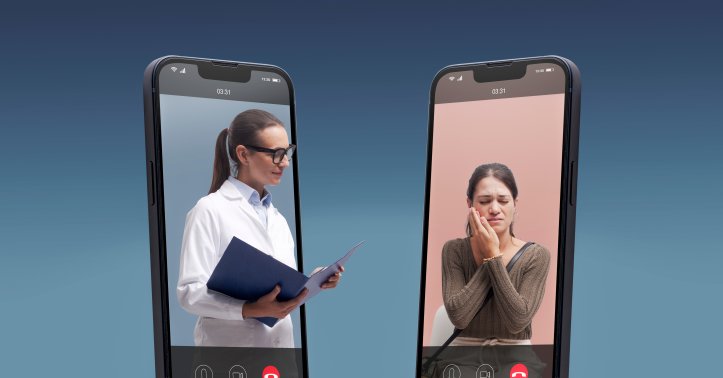
The Rise Of Virtual Dental Consultations: How Effective Are They?
Virtual dental consultations have become increasingly popular these days, especially after the recent COVID-19 pandemic. These distant consultations allow patients to receive dental care from the comfort of their homes without physically visiting a dental clinic. But how effective are they?
Research studies have shown that teledentistry is as effective as clinical dentistry for diagnosing problems. Enabled by video conferencing and image-sharing apps, virtual dental consultations promise greater convenience and accessibility to advice from certified dentists.
As technology advances, virtual consultations are likely to become even more effective and accessible moving forward.
Dental Conditions Treated Over Online Consultation
Virtual dental consultations are well-suited for these concerns:
-
Dental Pain Or Sensitivity Diagnosis
A virtual dentist interviews patients about pain symptoms to determine likely causes and suggest home remedies or further treatment.
-
Cavity Risk Assessment
Dentists identify patient cavity risk factors through questions and advise on adjustments to hygiene, dietary, or fluoride use habits accordingly.
-
Prescription Refills
If dentists approve via assessment, patients can request medication prescription extensions or changes during remote appointments.
-
Questions About Dental Braces Or Aligners
Orthodontic advice on aligner maintenance, discomfort, and post-procedure instructions is accessible from virtual dentists.
-
Mild Oral Infections
Video consults allow diagnosis of minor mouth infections like thrush or canker sores and calling in of soothing or antifungal medication if warranted.
Benefits Of Virtual Dental Consultations
Virtual consultations offer dentists and patients an excellent opportunity to connect and gain several benefits. If you’re skeptical about remote dental care through teledentistry, here are the reasons why virtual services are worthwhile:
-
They’re Relatively Affordability
Without clinic overhead costs, virtual consultation fees are significantly less than in-office visits. Patients also save on gas and travel time. The price difference provides a motive alone for minor issues.
-
They’re Useful In Providing Urgent Assistance
Getting immediate guidance during sudden dental emergencies offers welcome relief. Instead of weathering pain while waiting for on-site appointments, patients can quickly get provider assessments and treatment direction via telehealth dental meetings.
-
Optimized In-Person Care
Virtual consultations save chair time for more complex procedures by remotely handling minor questions and concerns. The right balance of virtual and in-office visits optimizes patient experiences and dental team resources.
-
They Offer Appointment Accessibility
Life gets busy, and dental care is often neglected as a result. Luckily, virtual consultation apps provide an instant portal to professional advice whenever a dental concern springs up – no long-term planning for scheduling is necessary.
-
Virtual Dental Consults Allow For Eco-Friendly Operations
With less travel and single-use supplies needed per consultation, virtual dentistry reduces waste and carbon footprints. The format provides a model for sustainable healthcare delivery overall.
-
They Can Calm Anxious Dental Patients
The dentist’s clinic can be an anxiety-inducing environment for many patients. Nevertheless, virtual consultations alleviate common fears and calm nervous patients before they enter the clinic.
Through video chats, dentists can nurture relationships and establish trust with apprehensive patients in a more relaxed setting. This allows the patient to open up about concerns and have questions answered transparently. As comfort levels rise, the patient may feel more comfortable booking that first cleaning or checkup if a cavity is suspected.
While skepticism exists, the dental industry recognizes virtual services’ tangible patient perks and responsibility upside. As options expand, so will positive transformations for dentists and those they serve.
Limitations Of Virtual Dental Consultations
Virtual dental appointments, although lauded for their usefulness, come with certain disadvantages with regard to providing oral care to patients. They include the following:
-
There’s No Thorough Oral Case Examination
Virtual dental consultations can be limited compared to in-person oral exams in terms of dental experts’ case examination capabilities. Dentists can’t directly visualize or palpate problems like damaged teeth and swollen gums during telehealth services, restricting their diagnostic capabilities.
While virtual visits can provide initial screening and triage, more complex oral health issues often require an in-office exam and possible radiographs/scans for a more comprehensive diagnosis.
-
There’s Narrow Procedure Capabilities
While advice, triage, and prescriptions are feasible remotely, anything involving dental surgery, tooth extraction/replacement, drilling, or implants requires an office visit. Many common oral health interventions just can’t happen virtually.
-
Virtual Dental Consults Pose Insurance Limitations
Most dental insurance plans classify tele-dentistry services as experimental or alternative, leading to lower coverage levels than traditional in-network care. Out-of-pocket costs may be higher compared to traditional dental visits.
-
Privacy Compromises Are A Real Thing
Transmitting dental images or health details over the internet, although protected by strict data policies, raises concerns about patient privacy issues. Hacks and leaks of sensitive information are a real thing and can negatively impact victims’ personal privacy.
-
Access Barriers Are Ever So Present
Low-income groups lacking reliable internet/devices, disabilities impeding camera use, or language barriers for instructions can curb access and effectiveness of virtual dental appointments for vulnerable groups.
Final Thoughts
The recent rise in virtual dental consultations has increased access and convenience for many patients seeking oral care services. But these remote visits, although effective, can’t fully replace traditional in-office dental exams and treatment.
While virtual consults are helpful for initial triage and minor issues, they have significant limitations in visualizing and diagnosing more complex oral health problems. Dentists require hands-on, tactile assessments to evaluate cavities, gum disease, and other conditions thoroughly.








